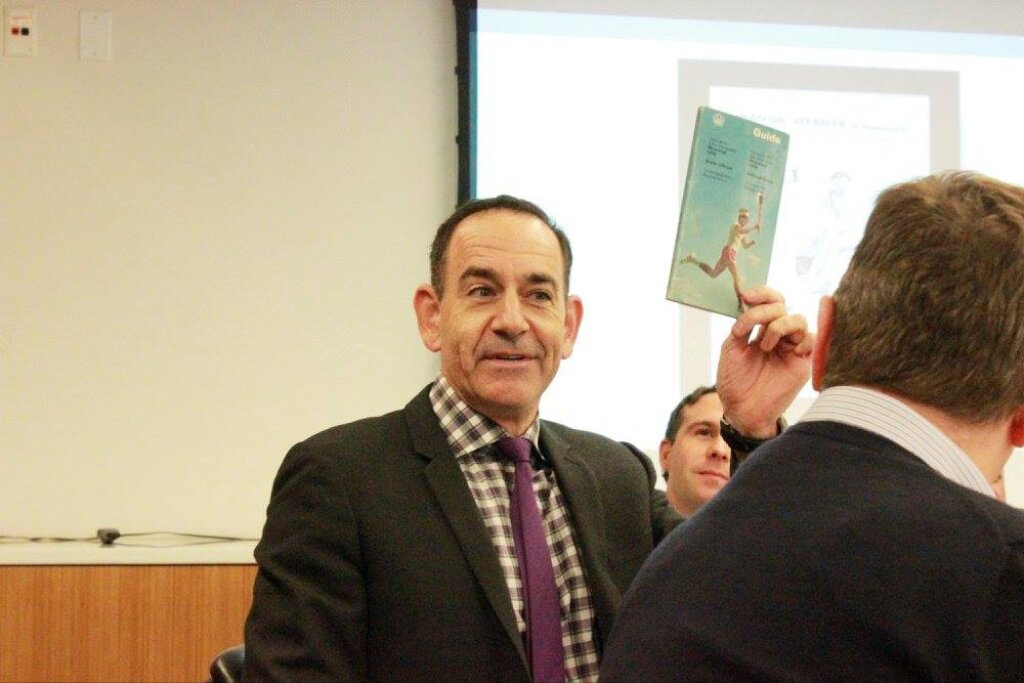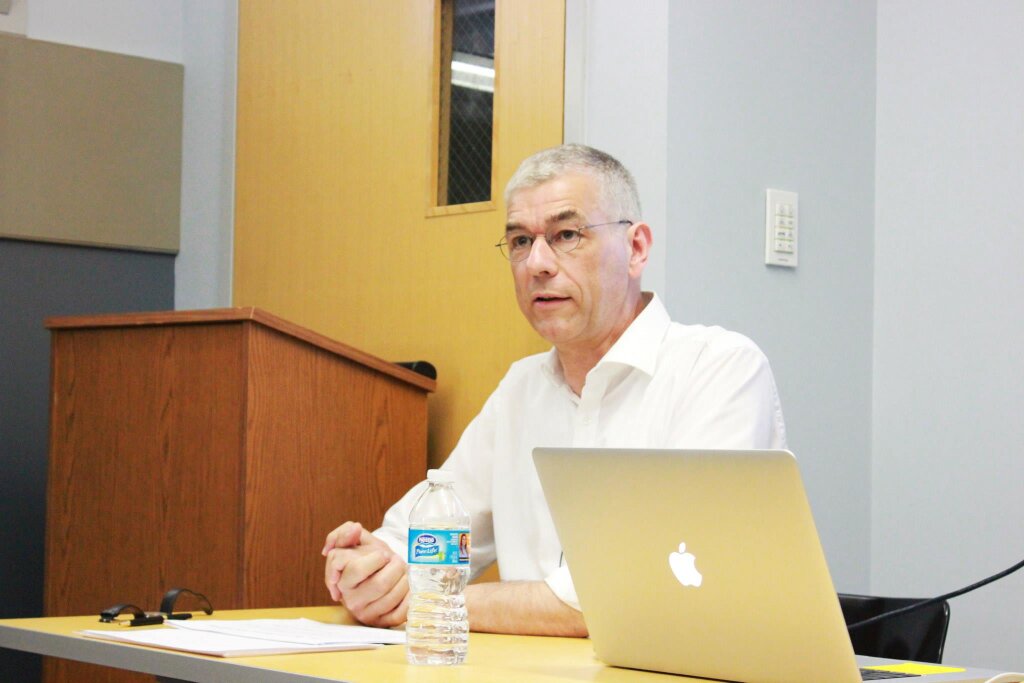Watch the video of the Public Forum here
On October 23, 2015, the NYU Jordan Center for the Advanced Study of Russia opened the New York session of “The Global History of Sport in the Cold War,” a two-day conference devoted to exploring the role of sport during the Cold War. The event was organized by Professor Robert Edelman from the University of California, San Diego, and Christopher Young from the University of Cambridge. It was supported by the National Endowment for the Humanities, the NYU Department of History, the NYU Center for the United States and the Cold War, the Woodrow Wilson International Center for Scholars, the University of Cambridge, the University of California, San Diego and the NYU SPS Tisch Institute for Sports Management, Media, and Business.
The conference consisted of a series of panels that brought together specialists from a variety of fields, in an attempt to put discussions surrounding sport during the Cold War in a comparative and global perspective. “Sport history has come a long way and needs to be taken seriously,” said Jordan Center Director Yanni Kotsonis in his introduction. The conference followed a session in Moscow and is part of a multi-year international research project that seeks to gather ideas and material for a book on sport within the Cold War context, as Edelman explained. “We were happily surprised to get over 90 proposals from all over the world,” he added.
Check out our report from Day 2
Panel 1 | Cold War States and Sporting Systems
The first panel brought together Toby Rider (California State University, Fullerton), Mikhail Prozumenshikov (Russian State Archive of Contemporary History), Mike Dennis (University of Wolverhampton) and John Nauright (University of Brighton). The discussion, which zoomed in on the peculiarities of sport systems in four countries, was moderated by NYU Professor Tim Naftali.
Rider began with a presentation of his paper, “Projecting America: Sport and Early U.S. Cold War Propaganda,” which focused on the U.S. perspective on sport during the Cold War. He noted that in the 1940s and 1950s, the U.S. government attempted to harness the diverse sporting landscape as a propaganda tool in order to present an appealing image of the American way of life and illustrate its vitality and merits. The intention, Rider claimed, was to persuade foreigners to reject communism. He drew particular attention to the propaganda strategies and materials employed by the U.S. government. “The scope of the U.S. information program was pretty startling,” Rider said. He also noted how the “rags to riches” plotline, inherent to the concept of the American dream, was ideally expressed through sport, since “anyone could progress through hard work and on his fortitude.” Rider pointed out that there were some limits to the reach of U.S. sport-related propaganda, considering that the message at times was lost in translation. Furthermore, “the outcome of a sporting event carried a message that could not be controlled.”
Subsequently, Prozumenshikov proceeded to illustrate the main findings of his paper, titled “Leonid Brezhnev and the Soviet Olympic dreams,” which focused on the figure of Soviet leader Leonid Brezhnev and his relationship to sport. In particular, Prozumenshikov noted that Brezhnev was a fervent sports fan and supported a proposal for Russia to host the 1964 Olympic Games. Khrushchev, however, opposed the idea, and Brezhnev’s dismissal from the post of Chairman of the Supreme Soviet might have been partly related to their discordant views on the matter, Prozumenshikov said. Furthermore, various obstacles, from the lack of Soviet infrastructure to concerns over the uncontrolled access of western tourists and press into the Soviet Union, stood in the way of a Soviet bid to host the Olympics. Economic considerations became of particular relevance in 1975 when the Soviet Union was awarded the 1980 Summer Games; after reading a report documenting the decline of the Soviet economy, even a sport enthusiast like Brezhnev showed moments of hesitation to carry on with the event, Prozumenshikov said.
In the third presentation, Dennis focused on his paper, “Sport and Politics in the German Democratic Republic (GDR).” He started by highlighting how the GDR was rather successful in toppling the goliath of U.S. power and outstripping the Federal Republic in the athletic sphere. Sports allowed the GDR to achieve one of its goals—international recognition—through what he defined as “diplomacy in tracksuits.” He also noted that progress in sport happened simultaneously to the détente and the end of the Soviet isolation. “But détente brought many risks and dangers for the leadership,” he added, stressing the importance of the competitive relationship with West Germany. Through surveillance and the creation of state-run doping programs, the Communist party made dangerous investments to develop the country’s sports elite.
Finally, Nauright shifted the focus to South Africa with a presentation of his paper, titled “South Africa: Apartheid Sport, International Relations and the Role of New Zealand in the Cold War Era.” The speaker prefaced his talk by describing the country’s political profile during the Cold War as “ultra-conservative and racist” and emphasizing the problematic elements of discussions around race, as showed, for example, by the existence of two white groups – English-speaking whites and Afrikaners—holding different social statuses. Afrikaners were European settlers; they controlled two states that were rich in diamonds and gold. Their monopoly subsequently led to the first Boer war and forced many Afrikaners into concentration camps, where many first became acquainted with the game of rugby, a British import. The sport quickly became extremely popular in the Southern Hemisphere. Nauright then moved on to discuss the importance of sporting boycotts against South Africa because of its racial policy during the Cold War, as well as the country’s strategic position given its wealth of resources.
During the ensuing discussion, Naftali brought up questions such as the level of American resistance to the idea of the Soviet Union hosting the Olympics, the Nazi legacy in the sport sector, and to whom U.S. propaganda was directed.
Panel 2 | Cold War Bodies
For the second panel, Jordana Saggese (California College of the Arts), Thomas Hunt (The University of Texas at Austin) and Sayuri Guthrie Shimizu (Rice University) took to the stage for a debate on the different meanings assumed by the body in the Cold War era. Fran Bernstein from Drew University served as discussant.
In her presentation, based on the paper “The Black Athletic Body,” Saggese discussed the connection between sport, athleticism and masculine body politics. “I am not so much interested in sports as in images of athletes,” she told her audience in the introduction. Her study focused on “art as a site for gendering beliefs and values” through which concepts of gender are built, modified and naturalized. In particular, she looked at visual representations of boxing scenes to draw attention to the commodification of men of color. Saggese noted how the boxer was seen as a trope that could help solidify the U.S. image during McCarthyism. For example, the American boxer Cassius Clay played the role to perfection in his role as an American representative abroad during the 1960 Olympic Games in Rome. Following his conversion to Islam and name change to Muhammad Ali, the boxer’s image switched from respectable figure to renegade. She illustrated this point by looking at a famous photograph by John Rooney of Ali after his 1965 defeat of Sonny Listo. In the picture, Ali is portrayed as an aggressor. Saggese also spoke about a controversial 1968 cover of American magazine Esquire, in which the boxer is pierced by six arrows in the style of St. Sebastian. “Ali is penetrated before our eyes and his expression is one of ecstasy,” the presenter observed. “It is instantly homoerotic.” She argued that the image is an expression of the public domination of an athlete who moved from celebrity hero to pariah in less than a decade.
In the third part of the panel Guthrie-Shimizu discussed the content of her paper, “Japan’s Gymnastic Rivalry with the Soviet Union, 1952-1960.” As she said at the beginning of her talk, gymnastics was a fixture in the Olympic landscape, but it only gained international prominence in the post-war years. Guthrie-Shimizu took a historical approach in her research, which focused on the relationship between Japan and its rivals in the gymnastics field. For a while, “beating the Soviet Union became the collective obsession for the Japan men gymnastics team,” she noted. Japan succeeded in dethroning the Soviet Union in the 1960s as a leader in the field, but subsequently had to face the rise of the Chinese and U.S. teams. The speaker also highlighted the importance of economic factors in influencing the different countries’ performances in the sport.
Following the presentations, Bernstein raised a number of issues for discussion, questioning the meanings assumed by term “Cold War body,” the role of World War II in the development of the concept of the body and the masculinization and feminization of certain bodies.
Panel 3 | Public Forum: Selling Sport in the Cold War
The last event of the day was a public forum on the intersection between sport and politics, featuring Amy Bass, a professor of history at the College of New Rochelle, George Vecsey, a sports reporter at The New York Times from 1982-2011, and Jeremy Schaap, journalist at ESPN. The discussion was moderated by David McDonald, Professor of Russian History at the University of Wisconsin.
The panel drew primarily on the experiences and memories of the panelists dealing with sport during the Soviet era. Each speaker shared vignettes, conveying the constant tension between East and West at play in their lives and work. What stood out most during the Cold War in regards to sports was that “different matches emblematized different virtues of our respective systems,” McDonald said.
The panelists all agreed that the legacy of the Olympics today is due to the politicization of sports during the Cold War. “When Soviets showed up in 1952, it became ‘us’ versus ‘them’,” Schaap said. “Athletes from the US [were] going up against these vast systems, mobilized to win this war. It was easy to create a narrative around that.” This tension did not always produce negative results. Vescey said that during the Cold War “we learned to love a national team,” but that “you can also love other peoples’ nationalism.” Bass also mentioned that mass television coverage of the Olympics, which began in 1968, changed how people around the world thought of the Games. The visual component encouraged viewers to think of who the athletes were and thus where they were from.
As McDonald opened the discussion to the floor, Annette Timm, a professor of history at the University of Calgary, asked the panel about the relationship between Olympic athletes and the hosts of the Games. During the Soviet Union, she said, Eastern bloc athletes often spoke of the warm embrace they felt from their hosts. But Vecsey noted that during the Cold War, there was not always camaraderie among the countries of the Eastern bloc. He relayed an anecdote from his interview with the Czech tennis player Martina Navratilova, who remembered how a Russian opponent once told her that she would “need a tank to beat [her].” Navratilova was 12. Vescey also explained that the Prague Spring caused many athletes to defect, including Navratilova herself. The panelists also agreed that during the Cold War, unless the United States was involved in a sports event, the North American coverage of a sports event was likely to be poor. Other questions tackled issues such as the lack of Western reporting on Eastern European athletic victories, the nature of the Soviet press on sports, and the coverage of the 2014 Winter Olympics in Sochi.
Additional reporting by Natasha Bluth



